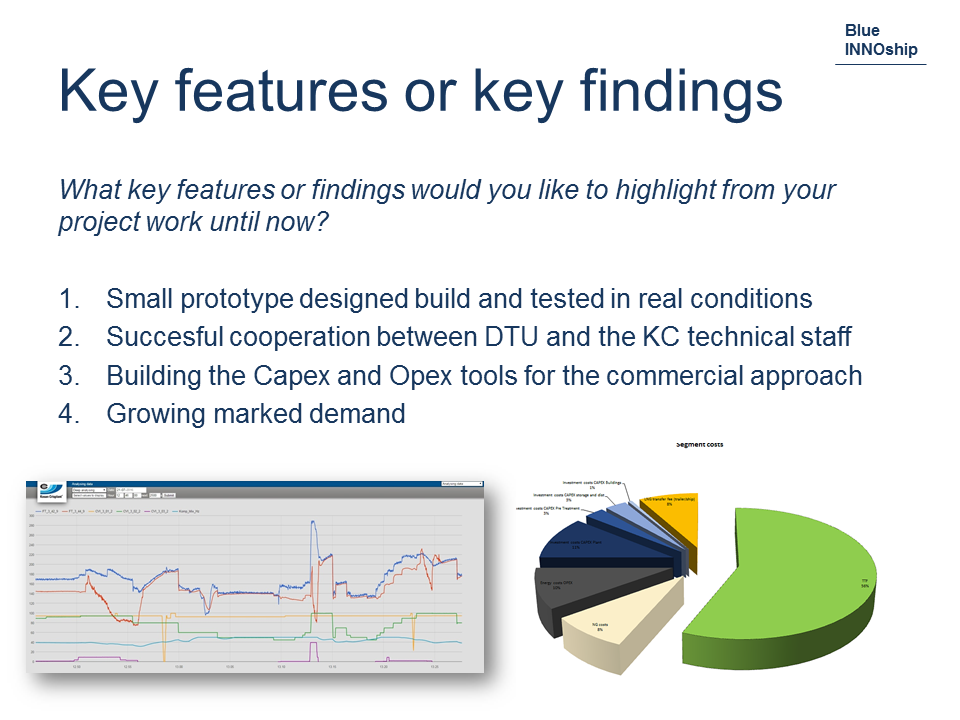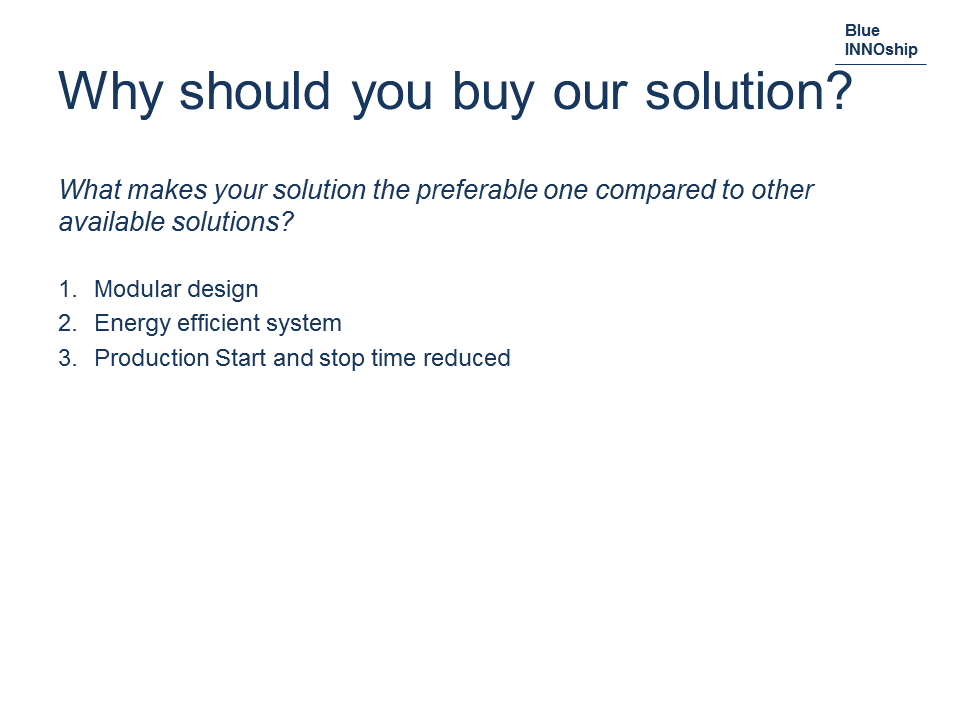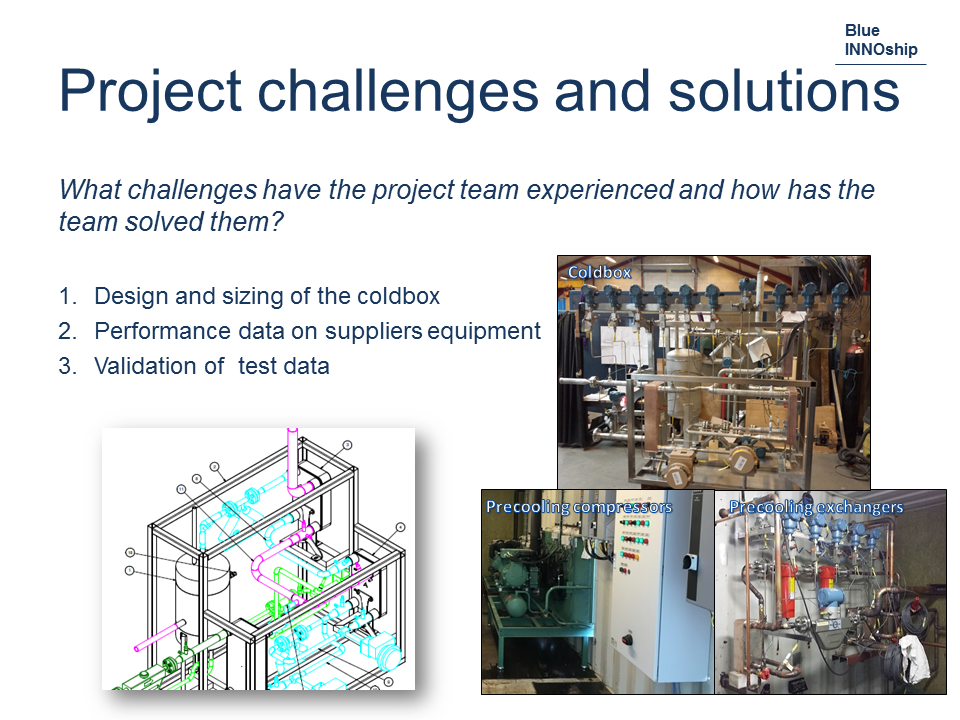|
|
Finalized
Project #10
Shore based small scale LNG/LBG liquefaction unit
| Goals and objectives |
|
Innovation of shore based LNG liquefaction unit which on demand can produce LNG/LBG bunker to the maritime industry.
- The liquefaction unit shall be able to connect to the Natural Gas network. - The liquefaction plants shall produce LNG on demand to feed LNG filling/bunkering solutions in Danish Ports. - It will be a modularized design and can be scaled to produce from 20-50 Ton/h. - The plant can, with a add on system, be connected directly to biogas plants and produce LBG direct. - It shall be “intelligent” and function fully automatic with short start-up and shut down cycles |
| Participants |
|
Kosan Crisplant
Moving Energy
DTU
The project is supported by the Danish Maritime Fund.
|
| Outcome from the project |
|
The collaboration project between Kosan Crisplant, DTU and Moving Energy has developed an energy efficient small-scale LNG/LBG production facility. Based on advanced simulations models created by DTU, used for optimization of the plant layout, a test facility was designed and built by Kosan Crisplant. Kosan Crisplant is now ready to take orders on liquefaction plants from 50 to 150 T/D
Kosan Crisplant and Moving Energy:
- Commercial calculation model
- Selection and test of critical components - In-house design of cold-box - Layout of a complete liquefaction plant - In-house competence build - technical and commercial - Design of pre-treatment system - Design and build of process control system and data collection for processing test data - National and international interest in this new product
DTU:
- Simulation models:
- Aspen+ model of the optimized 50ton/day production facility
- Aspen+ model of the test facility
- Aspen+ models of CO2-separation processes for natural gas purification (before liquefaction)
- Aspen+ models of gas liquefaction processes (mixture-based refrigerant, cascades and expansion-based) developed in the natural gas industry
- 2 papers in international scientific journals
- 3 papers presented at international conferences
  |
| Reporting from the project |
|
How would you describe the results obtained in the project?
An energy efficient small-scale LNG/LBG production plant, has been designed, dimensioned, developed and tested in this project. The project lead to a fruitful partnership between DTU and Kosan Crisplant, which made it possible to exploit competencies and knowledge at DTU within advanced thermodynamics, numerical modelling and optimization and in order to design, build and run an optimized test facility.
Moving Energy has developed a pricing template that enabled the KC commercial team to calculate and present the important figures and energy comparisons toward other fuels for the market.
Kosan Crisplant has achieved internal learnings and has updated our organization technically and commercial during this project stage. Kosan Crisplant contracted COWI as special consultant in thermodynamic practice. COWI has been the link between DTU very high theoretical knowledge and to the mechanical solutions.
This arrangement also was the key to anchor the knowledge inside Kosan Crisplant own organization.
How would you describe the process leading to these results?
The results were achieved by a dedicated effort from all partners. Close collaboration between Kosan Crisplant, their consultants, DTU and Moving Energy throughout the project period made it possible to convert the theoretical results of simulation models in to a practical running system. Especially in the period of designing and building the test, facility close collaboration was necessary. Whenever facing practical problems in the project, the dedication towards the goal of building a running test plant did not diminish, and all partners made an extra effort to overcome the problems.
Note: The test plant was not supported in this project, it has been own financed. Early in the process, we realized that a test plant was needed to verify and challenge the results from the theoretic models.
The design of the cold box in the test plant was also a good practice for the Kosan Crisplant in-house engineering as its design is very close to a full scale cold box.
Please summarize the key activities conducted in the project
Kosan Crisplant key activities:
1) Project owner and administrator
2) Commercial activities and marketing of a full-scale liquefaction plant. Building the Port of Frederikshavn business case, calculate and make firm offers for land based liquefaction plants of 50-150 T/D modules.
3) Design of 50T/D modules and selction of main components
4) Design and layout of a complete plant, with production facilities, storage, truck loading and ship bunkering
5) Selection of natural gas pre-treatment plant. Design and selection of it.
DTU key activities:
1) State-of-the-art review of LNG small scale liquefaction plant, which guided the choice of technology for the test facility, i.e. selection of the mixed refrigerant refrigeration cycle solution.
2) Development of simulation models of the a) target plant producing 50 ton LNG/day and b) the test facility cooling down nitrogen. Models were developed in Aspen+.
3) Multi-objective optimization of the plant design: Optimization of the mixture refrigerants to be used in the system and optimization of operating conditions i.e. optimal temperature and pressure levels in the system taking into account the composition of natural gas.
4) Development of the process and instrumentation layout of the test facility in collaboration with Kosan Crisplant.
5) Participation in the experimental test runs.
6) Data analysis of experiments and validation of the simulation models based on data from the test facility.
Moving Energy key activities:
1) Development of a LNG business case calculation tool
2) Study market opportunities for small scale liquefaction plants in Europe as well as US
3) Environmental and safety studies and the effect on permit processes in different countries
4) Safety considerations on complete plants with storage facilities
5) Cooperate and train Kosen Crisplant commercial staff
Were there any concerns about the projects outcome during the project and how did you overcome them?
Several problems were faced in the period of building the test facility and making it run. Several of the components did not perform as expected, mainly because the working conditions are beyond standard conditions. The problems were overcome by initiating a close collaboration with the component suppliers. The component suppliers were interested in making their components work under the specified conditions. However, these issues resulted in a time delay.
There was a constant pressure from the commercial department for having a valid project calculation in order to price a plant. Already in an early stage we had to select main components and from these price indications and help from COWI we managed to price a 50 & 150 T/D complete production plant. This enabled the commercial team to approach the market.
Which positive findings or news did your project disclose?
The project has shown that it is possible to design a small-scale LNG production plant with a theoretical energy consumption 40% lower than the European target.
Why was the project worth the invested resources?
Kosan Crisplant: We got access to 5000 highly specialized hours from DTU and a fantastic partner with full commitment and that had entered a lot of effort into this project. DTU: Because we got some nice results and initiated a partnership with Kosan Crisplant, which has already led to new project ideas. We have become a leading research organization within LNG production using mixed refrigerants. Moving Energy: Developing of commercial calculation models based om complex theoretical models and real data from a test plant is not always possible to have in a R&D project.
What key learnings did you obtain through the project?
LNG production is complex and a very sensitive operation. We learned how to design an energy efficient LNG production facility working within a safe operation window. We learned which cycle design, which refrigerants and which components to use in such a facility. The Kosn Crisplant organization is today commercial and technical ready to sell and design a plant. How was the cooperation between the partners? The cooperation between the partners was good. In the beginning all partners had to learn the others working styles, but along the way the collaboration got easier and closer. The cooperation was very much focused on the results and very good in this regard, but the cooperation on formal project management and reporting to the BlueINNOship secretariat could have been better.
What could have made the cooperation work better?
Running a large development project is a special task. It took some time for, especially for Kosan Crisplant to be used to work with a university (DTU), private company (Moving Energy) and a consultant (COWI) in the same project. To get used to the different perspectives and thinking of people from different worlds was a challenge. It took some valuable time to be on the same page. An external allocate project manager, it could be from Blue Inno, to kick start the project and facilitate the cooperation in the start phase would have been an advantage. Did any partners not deliver as anticipated? And what did you do about it? The test facility was delayed due to technical challenges with components. This resulted in a time delay, and DTU was not able start the tasks on data analysis and validation according to schedule. The time schedule was revised and the project was extended for DTUs part.
What could have made the project work better?
The component challenges had not been foreseen. Since the operating conditions of the facility are far from standard conditions for the components these could have been targeted earlier in the project.
Did you have to change scope or process during the process in order to finalize the project?
Due to delays in making the test facility able to run, the time schedule could not be kept, and the project period was extended by 3 months for DTU making it possible to finalize the data analysis and validation of the simulation models.
 |
| Presentations, articles and media coverage from the project |
|
Presentation at IDA conference
Techno-economic optimisation of three gas liquefaction processes for small-scale applications. Nguyen, Tuong-Van; Rothuizen, Erasmus Damgaard; Elmegaard, Brian; H. Bruun, Allan. Published in: Proceedings of ECOS 2016: 29th International Conference on Efficiency, Cost, Optimization, Simulation and Environmental Impact of Energy Systems
Development, modelling and evaluation of a small-scale gas liquefaction plant. Nguyen, Tuong-Van; Rothuizen, Erasmus Damgaard; Markussen, Wiebke Brix; Elmegaard, Brian. Published in: Proceedings of ECOS 2017: 30th International Conference on Efficiency, Cost, Optimization, Simulation and Environmental Impact of Energy Systems
Techno-economic analysis of LNG production alternatives. Matteo Nagy. Master thesis DTU
Modelling and Optimisation of Cascade and Mixed Refrigerant Cycles for Natural Gas Liquefaction. Nicola Lonardi. Master thesis DTU
Assessment of thermodynamic models for the design, analysis and optimisation of gas liquefaction systems. Tuong-Van Nguyena, Brian Elmegaard. Paper
Thermodynamic comparison of three small-scale gas liquefaction systems. uong-Van Nguyena, Erasmus Damgaard Rothuizen, Wiebke Brix Markussen, Brian Elmegaard. Paper
Shore-based small-scale LNG/LBG liquefaction unit. Tuong-Van Nguyen, Erasmus Damgaard Rothuizen, Wiebke Brix Markussen, Brian Elmegaard. Poster
|